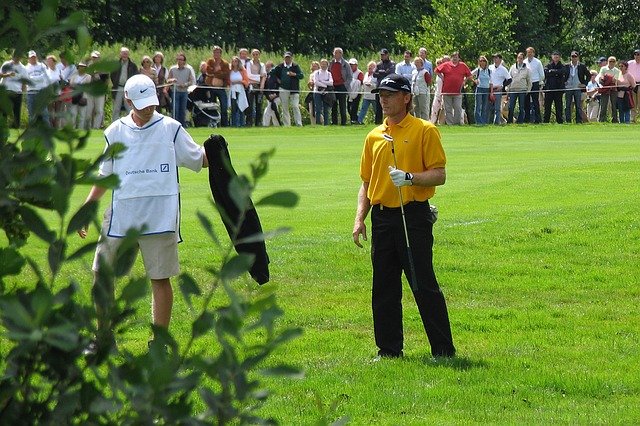
Golf takes a sport of great patience and skill. The main goal of golf is to hit a tiny ball hundreds of yards with a club into a cup that is little more than 4 inches wide. Read the tips below to see what you can do to play like a pro.
It’s always best to walk the golf course, instead of using a golf cart to get around. Walking the course will help you to get more exercise while golfing and will simultaneously improve your game by improving your strength and endurance. Walking also keeps you loose and warms up your muscles.
Your entire body is important to golf. Your whole body is needed to truly power your shot. Your whole body is instrumental in moving the club. You will be able to control the ball farther without injuring yourself.
You’ll find that your whole body becomes completely engaged when playing golf. Your body is the power source, not only your arms. Let your body be one with the club. This allows you to increase your distance without placing unnecessary strain on your arms.
One of the first things to consider when starting to learn a golf is proper grip. Try gripping soft, but firm grip on your club to maximize your swinging potential. Hold the golf club as if it were cradling a bird.
One of the first things you want to get down when learning golf is the proper grip for all of your clubs. Typically, people think that they will be able to hit the ball further by commanding a hard grip on the club. However, you can get more distance by have a firm but soft grip. Hold your club similar to how you would a bird.
Use the entire body for more power when swinging the golf club. Beginners often mistakenly believe that the arms power the swing, but using the arms only leads to a low-power, weak swing.
Use your entire body to power your golf swing. Inexperienced golfers often mistakenly believe that power should come only from the arms. However, unless you use your entire body, your swing will be weak. Put the momentum of your whole body behind every swing for maximum distance.
When addressing each putt, look down and make sure your left hand is set a little forward of the ball before you strike it. Maintain this position while you follow through with your swing.
Every golf club has a “sweet spot” – the point on the face where a ball struck with a good swing has perfect accuracy. Regular and consistent practice with each club in your bag will show you their individual sweet spots over time. Once you know them, always remember to contact your ball with the sweet spot at the farthest reach of your swing.
When faced with a long putt, it is important to focus on the speed of your swing and the velocity of the ball itself. This ensures you don’t overshoot the distance required of your next putt is simple to make.
Focus 100% on your upcoming shot. Don’t dwell on a bad play at the previous hole, or worry about what’s up ahead, but concentrate on the task at hand. Fretting about mistakes will affect your swing; just forget about them and move on.
Ank Player
A long putt requires you to focus on the speed at which you will be hitting the ball. Do not concentrate solely on your aim; you should aim for a target that is between the ball and the hole. This ensures you don’t overshoot the hole and your next putt is simple to make.
Knowing how to keep score is a crucial element of playing golf. Your average score is what is usually used to judge your ability as a D-rank player or an S-rank player. The goal is to minimize the number of strokes as you to get the ball into the hole.
For a powerful swing, use all the muscles in the body, especially your core and leg muscles. Simulate the cracking of a whip while you swing your torso around and push your feet firmly against the ground. The energy for the arched swing begins in the feet and is transferred up through the legs and into your trunk and arms.
To generate a truly powerful swing, you need to utilize the muscles in your whole body, particularly your trunk and legs.
Use a light, neutral grasp on all of your golf clubs. If your grip is too tight, you will likely steer your shots to the right. On the contrary, holding the club too loosely will steer the ball to the left. Let the direction you want your shot to go direct the grip you have on your golf club.

Don’t mess up your game by trying to position yourself into an unnatural stance. Practice concentrating on the ball sans club. Flex you knees, bend your waist slightly, and have you arms fall easily in front of your body. Have one hand grasp the other and then hold them there.This is all there is to a natural position, and if you are not comfortable, you are overcompensating on the position.
For a drive swing, align the ball with your front foot. For other swings, position yourself so that the golf ball is evenly between your feet. The exception to this is when your ball is positioned on a slope.
This will help ensure that the ball to travel in a completely straight line. Practice adjusting the angle of your swing until you have learned how to center your shot.
Be sure you are using appropriate posture to maximize the impact of your golf swing. How you address the ball usually determines how far and where the ball will travel. Slouching or hovering will result in your ball, having less projection than it would with a confident, expert pose.
You will be more motivated if you truly enjoy playing golf. Practice whenever you can, and look for more information and assistance to improve your game.
Before you begin your swing, be sure to hold the golf club in the correct way. The handle should rest on your palms with your thumbs pointing down. Your hands should be touching each other. When you want to hit your shot as far as possible, you must choke the club slightly as you swing.
Breathe in deeply just before hitting the ball. Doing this can clam you find your calm and lets you focus on the ball. Take your time to envision where you would like the ball landing and swing. Deep breathing can also eliminate tension when competing.
Whatever you do, avoid the thought that a golf stance must be uncomfortable to be successful. Try addressing your ball without your club. Stand with your knees slightly flexed and bent at the waist, let your arms fall in the front of you naturally. Then clasp your hands as if holding a club and retain this position. This is what a natural position is, so if you don’t feel comfortable with it, you are most likely overcompensating the position.
A time-tested adage for golfers is always keep your focus on the ball. This rule holds true for all ball-based sports, but is just as important in golf. Keep your eyes firmly on the ball, eyes on the ball, when you are swinging.
Always use the proper stance. If you don’t know if you’re standing properly, you can find out by doing an easy test. Just try tapping your toes upwards and downwards while keeping your feet still. It should take only a little effort to tap. It will be almost impossible to execute this movement if the weight of your body is positioned too far in front of the ball. On the other hand, it will be entirely too easy to perform if your weight is too far behind the ball.
Avoid tensing up when you address the ball.This is a common mistake that many golfers need to solve to get better. Make certain you are not stiff!
Keeping your eye on the ball may be an old adage, but it will always remain the most basic of concepts. While this is true of many sports, it’s very true in golf. Thus, you should keep a lowered head with your vision remaining firmly on your ball from the point you take stance until the end of your follow-through.
Get golf shoes with some extra width to ensure that your feet don’t get sore as you walk.
Avoid tensing up before you address the ball. This is a common mistake among golfers, and it can greatly weaken your game. It is vital to be relaxed and not rigid if you want to hit accurately and powerfully. Therefore, be sure to loosen up before you take your swing.
Getting your ball out of these bunkers can really mess the sand up. Follow golf etiquette and rake the sand back into position before you take your next shot.
Anyone who wants to develop mastery at golf needs to learn how the types of clubs differ. Knowing whether you should select a wood, iron, wedge, or other club can help ensure that your ball always ends up where it should be when you are on the course. Utilizing the wrong club can spell disaster.
The sport of golf requires strength, skill, and precision. It is a sport which takes advantage of land, with the intent of getting a ball into a hole. While simple in design, golf is truly a sport that takes a lifetime to master. By following these pointers you can get a great start on a lifetime of improvement and enjoyment.
Practice is the key to resolving the common error of slicing. Slicing is caused by a clubface hitting a ball in a way it shouldn’t, which causes the ball to curve towards the right. Envision your target line and keep your hips, knees and shoulders parallel to it. Rather than using your body and shoulders on the downswing, use your hands and arms.


